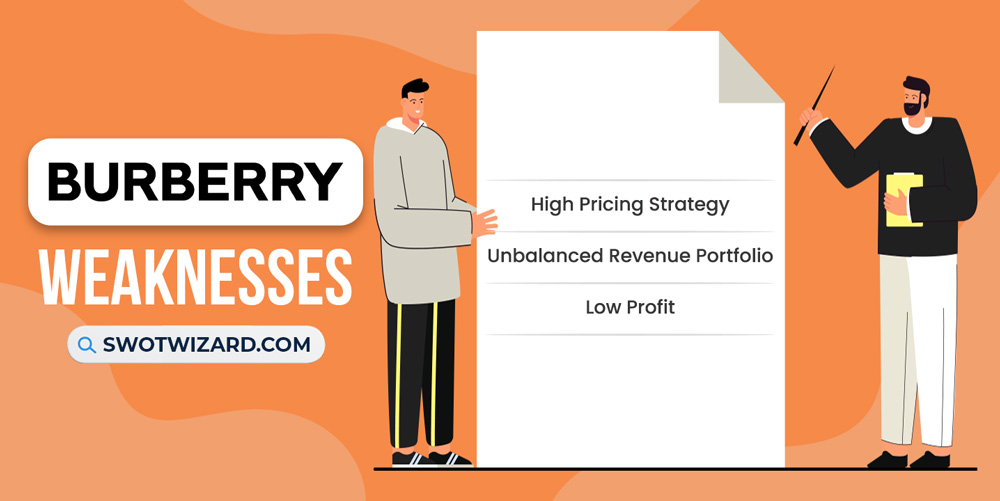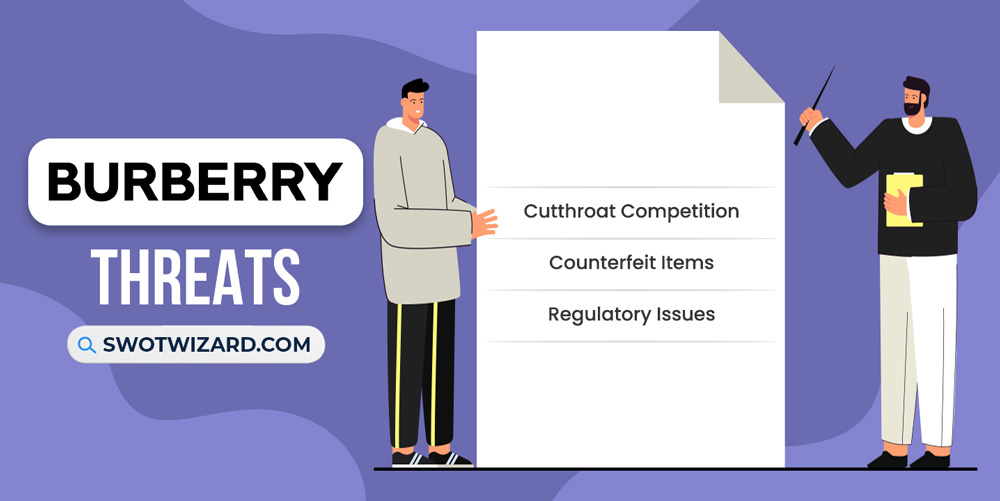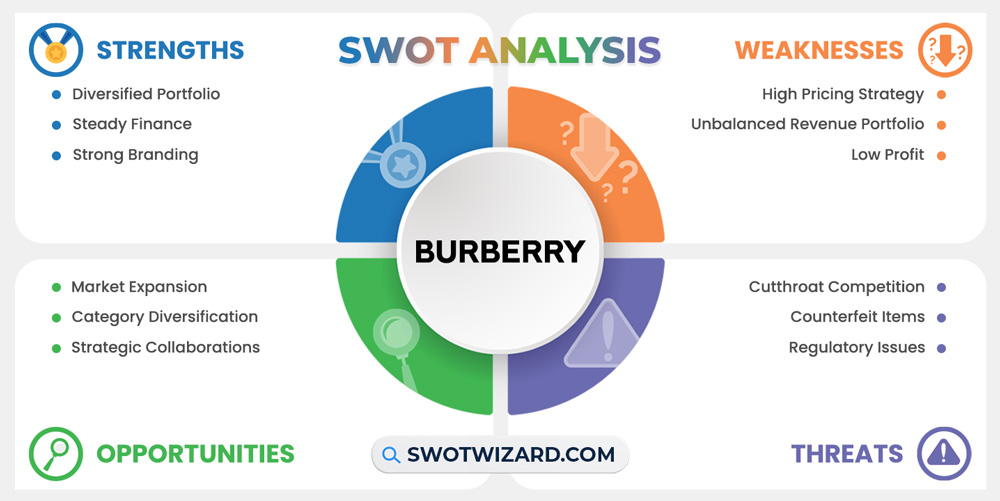Burberry has officially reached 34 countries, but the unofficial and counterfeit items have reached every corner of the world because of its luxurious fame and the value perception of the brand. In this Burberry SWOT analysis, I will discuss the company’s strengths, weaknesses, opportunities, and threats.
Burberry: Company Overview
| Company | Burberry Group plc |
| Industry | Fashion |
| Founded | 1856 |
| Founder | Thomas Burberry |
| CEO | Jonathan Akeroyd |
| Headquarter | London, England, UK |
| No. of Employees | 8,868+ |
| Annual Revenue | £3,094 billion (FY 2023) |
| Website | burberry.com |
Almost 170 years ago, in 1856, a British designer named Thomas Burberry founded the luxury brand Burberry in Hampshire, England. It was that company that invented gabardine, a breathable, weatherproof fabric used in the design of raincoats in 1879. And the rest was history, and now everyone knows it. To keep the engine running, the company employs around 10,000 people globally and generates revenue averaging around $4B.
Product & Services of Burberry
Ready-to-wear | Handbags | Leather Accessories | Footwear
Burberry Competitors
Armani | LVMH | Prada | Coach | Gucci | Versace | Christian Dior | Hermes | Kering | Kate Spade | Michael Kors
Did You Know?
Burberry holds royal warrants from Queen Elizabeth II and the Prince of Wales, a testament to its quality and service to the British royal family.
Strengths – Burberry SWOT Analysis

Diversified Portfolio: Over the past decade, the brand has diversified its offerings beyond the signature trench coat to include accessories, beauty products, and an expanded apparel line. As a result, it has also affected the sales as well if we see the data as accessories and beauty now make up over 50% of sales.
Steady Finance: Despite fluctuations in the broader luxury market, the company has maintained steady financial results, including positive comparable store sales growth for over five consecutive years. If we look into the data, in the past year alone, the company’s revenue grew by over 13%, showing its ability to maintain healthy profit margins and sustain growth.
Strong Branding: Burberry was among the top ten most valuable luxury brands in the world, with an estimated brand value of $6.4B, according to Interbrand’s 2022 rankings. That just didn’t happen in one night because, continuously evolving while retaining its quintessential British heritage, Burberry has successfully captured diverse consumer segments.
Weaknesses – Burberry SWOT Analysis

High Pricing Strategy: The brand has one of the highest average prices in luxury apparel, with polo shirts over $450 and coats priced at $2,000+, which limits purchase frequency. If we look at the price info from the website and compare them with the competitors, their iconic trench coat prices significantly surpass those of competitors, potentially deterring price-sensitive consumers and limiting market penetration.
Unbalanced Revenue Portfolio: Around 40% of Burberry’s retail revenues come from the Asia Pacific and Europe region specifically, highlighting susceptibility to economic fluctuations in these regions and presenting other overexposure risks. Again, if we compare the company with other biggest market competitors, the percentage is much lower and, to be specific, under 25%.
Low Profit: While top-line growth recovered post-pandemic, the company’s profit margins significantly trail leading luxury peers. In the last three years, their operating profit margin was around 15%, much lower than some competitors, indicating potential inefficiencies in cost management and operational strategies.
Opportunities – Burberry SWOT Analysis

Market Expansion: The news is not new, as China overtook the USA as Burberry’s top market in 2022, underscoring room for growth. Besides, Burberry’s Asia Pacific, especially India, sales surged by 31%, indicating the untapped potential in these regions. As per the sales estimation, the Chinese and Indian luxury goods market will grow at a 3-4% CAGR this decade as incomes rise.
Category Diversification: The brand could further leverage brand equity into new non-apparel categories like home goods. Other Competitors like Armani Casa have demonstrated additional monetization potential through branding into adjacent spaces. Not just that, the “My Burberry” line saw an over 47% growth in beauty sales in the same fiscal year.
Strategic Collaborations: Partnerships with complementary luxury brands allow creative reinterpretation of Burberry fashion legacy while exciting loyal consumers. Besides, recent tie-ups with streetwear label Supreme and sneaker brand New Balance illustrate potential. We can also see that the Burberry and Vivienne Westwood collaboration resulted in unique collections, garnering significant attention and reinforcing Burberry’s innovation and appeal.
Threats – Burberry SWOT Analysis

Cutthroat Competition: The luxury conglomerates LVMH and Kering are major competitive forces, together generating over $75B in apparel, leather goods, and beauty sales annually. Besides, in the last two years, after COVID-19, Gucci’s revenue surged by 20%, reflecting the competitive landscape Burberry navigates to sustain growth.
Counterfeit Items: Though Burberry employs strict supply chain controls, unauthorized copying still runs rampant in crucial Asian markets. Forget the Asian region; in the UK alone, there were more than ten thousand counterfeit Burberry goods seized by UK customs. If we look at the data, counterfeit products make up nearly 12% of China’s overall GDP.
Regulatory Issues: As a British brand, Brexit introduced uncertainties in cross-border trade, potentially disrupting supply chains and increasing operational complexities in the last few years and still going through many issues. Besides, the company also faces a growing stakeholder focus on environmental and social practices around raw materials sourcing, manufacturing, and transparency.
[Bonus Infographic] SWOT Analysis of Burberry

Recommendations for Burberry
Here are some recommendations for the British luxury brand for the upcoming future.
- The company should accelerate organic and partnership-driven retail growth across high-potential markets.
- Focus on continuous innovation, such as sustainable materials, unique designs, or collaborations, to set Burberry apart in the competitive market.
- Communicate transparently about ethical standards and sustainable practices, resonating with conscientious consumers and potentially driving sales growth.
- Pursue deliberate brand extensions into related lifestyle categories like luxury homewares, watches, jewelry, and children’s apparel.
Frequently Asked Questions (FAQs)
In which country is Burberry cheapest?
Burberry is the cheapest In EU regions.
Is Burberry a royal brand?
Yes, Burberry is a royal brand.
Final Words on Burberry SWOT Analysis
Burberry retains substantial strengths as an iconic luxury brand with high growth potential stemming from emerging markets, innovation, and lifestyle expansion. However, realizing the upside requires mitigating overdependency on specific geographies and channels while fending off external threats like competition, counterfeiting, and exposure through careful strategic adaptation focused on diversity, regionalization, and operational balance.
References
- Wikipedia contributors. (n.d.). Burberry. Wikipedia.




